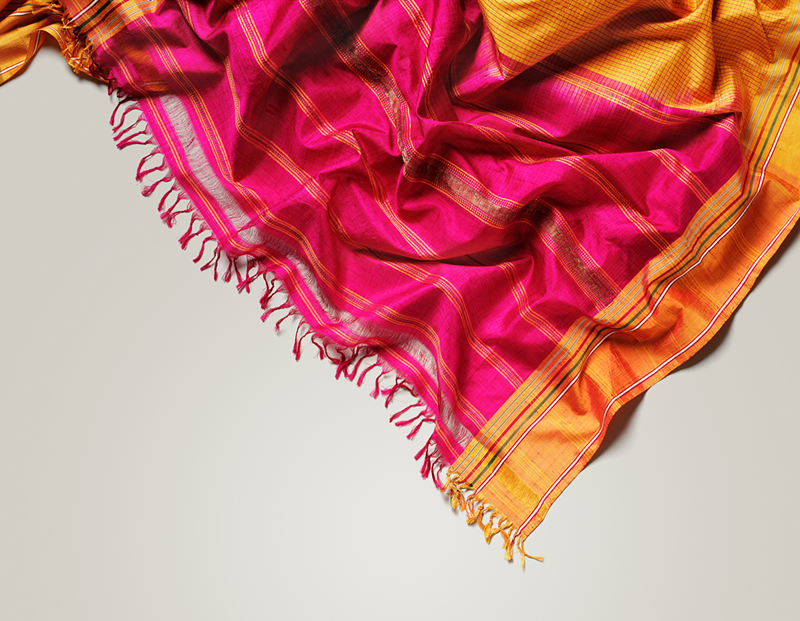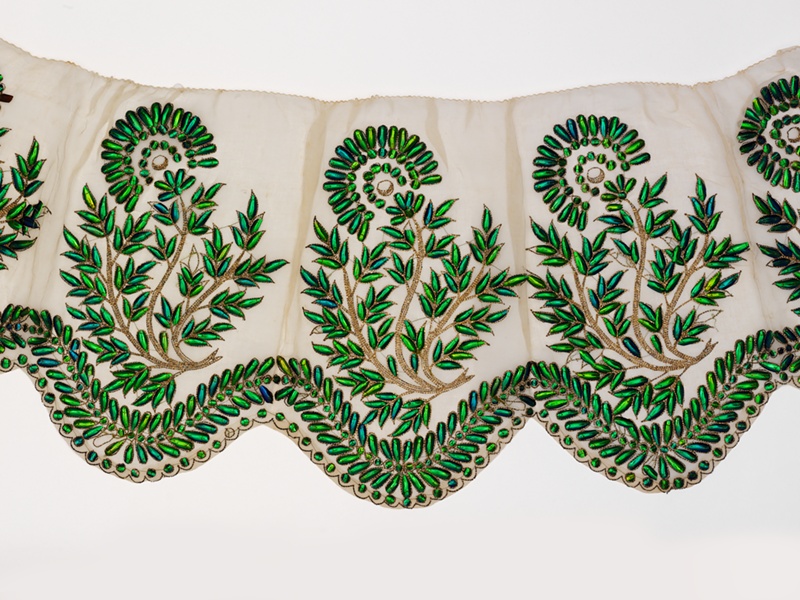
Stroll inside the Cincinnati Art Museum and be greeted by their newly-opened, sprawling exhibit, The Fabric of India. Inside, the textures are warm with intricate, labored designs; one piece, a border of a dress, is even embroidered with the wings of Jewel Beetles. Peering into the glass case, the wings’ emerald shine shimmers back.
The gallery — which features over 170 handmade objects — will be on view in the Western & Southern Galleries, the same space occupied by the former (and one of the museum’s most visited attractions) Terracotta Army exhibit. Organized by the Victoria and Albert Museum in London, guests will have the chance to explore handmade Indian textiles through Jan. 6, 2019. Though general admission to the museum is free, tickets to this exhibit range from $6-$12 (if you're a member, it's free).
Other objects include a 19th-century map shawl; from a bird-eye’s view, the city of Srinagar stretches, dotted with homes, mosques, waterways — including Lake Dal and the river Jhelum — and urban-meets-countryside sprawl. In one room, a vibrant wall hanging fills every wall, awash in hues of red, off-white, forest green and gold. Called a “bhitiya,” it was made to decorate a room during a festival or marriage. Remarkably, the piece was found on a New York City sidewalk in 1994, and dated to have been made between 1920-40.
Softly-tinted flowers bloom along a long piece of fabric, stitched in silk velvet and silver-wrapped thread. Despite the “flower border” being dated to 1640-50, the thread’s calming colors are still intact.

But the exhibit’s strength is its need to shape a history. Before Western influence ever came to the continent's shores — and clamoring to claim the colorful textiles Indians crafted — handwoven, printed, dyed and embellished fabrics were a core part of the region’s identity. Today, that still remains, just in an evolved form. And Fabric of India points to this passage of time. Full stop: You should read each placard carefully, as each reveals a new slice.
According to a press release: “The exhibition is organized in six thematic sections, exploring courtly splendor exemplified by sumptuous fabrics and dress alongside finely crafted sacred cloth used for religious worship. Centuries of global trade shaped by the export of Indian textiles is examined, illustrating a robust aesthetic exchange between artisans and their clients. The political power of textiles is considered through their use as a symbol of power and protest in the quest for independence in the early twentieth century.”
Modern designers are showcased, too — fashion designers on display include Manish Arora, Sabyasachi Mukherjee, Abraham and Thakore, Rahul Mishra, Aneeth Arora and others. By the time you reach the end, contemporary outfits and saris will greet you; their colors are still warm, with elegant and sleek fits.
In the press release, Cynthia Amnéus — Cincinnati Art Museum’s chief curator and curator of fashion arts and textiles — cites being excited to share this history with the community. Guests will have the chance to not only see pieces that haven’t been displayed before but also peer into the processes behind them.
Throughout each section, videos explain various histories and techniques, like “The Road to Independence,” which gives context to revolutionist Gandhi and the impact of not only his politics on India but his clothing, too. He was a leader of the Indian independence movement against British rule, and many would don ‘Gandhi’ caps as a way to protest.
Many pieces illustrate the rise of Orientalism and the effects of Colonialism, like a piece titled “Depicting Nations Hanging” (dated to 1640-50). On the upper half, two men and two boys don Eastern dress, but their striking blue eyes paint them to be Westerners. Below, women wear a mix of European and Indian styles. The placard beside the hanging notes that such themes would become more present in the coming century.
“This is an amazing opportunity for visitors to see this landmark exhibition, the first to examine the diversity and richness of Indian textiles in depth,” Amnéus says.
Next weekend, the museum will also host "Art After Dark." This time, the theme is "Diwali," an Indian festival celebrated every autumn. Expect live music, tours, henna tattoos, dance performances, cocktails and food for from Bombay Brazier and Amma's Kitchen. And, hey—you can get into Fabric of India for free.
More info: cincinnatiartmuseum.org.

